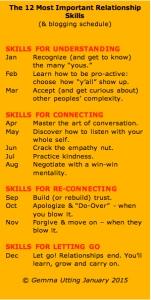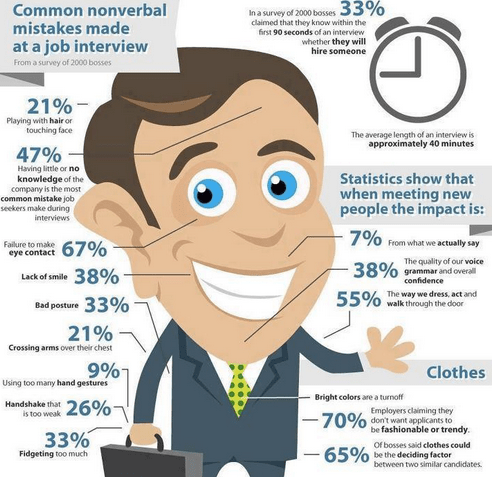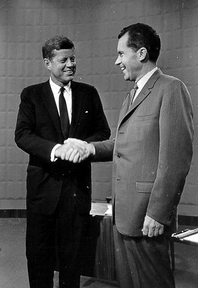Would you want to ~
- Know what someone was feeling, without asking them?
- Influence what someone thought about you, without saying a word?
This month, I’m hoping to boost your understanding of other people by beginning with the loudest messages that are coming at you – those silent, non-verbal ones.
This is definitely a brief whet-your-appetite piece since there is so much written about non-verbal communication.
However, armed with just these five non-verbal behaviors you’ll be way ahead of the game when it comes to understanding what someone else is feeling and thinking.
And – jolly helpful here – as you begin to crack these non-verbal languages, you can script what you’re broadcasting with a bit more care.
Here are 5 tips for translating those non-verbals into news you can use.
1. The Walk
OK, gotta mention John Wayne here. Here’s a “John Wayne Moment” from The Birdcage (one of my all time favorite movies – this is the American version of the French La Cage Aux Folles) ~
Everyone has a walk. John Wayne just had “such a walk”!
What matters about The Walk isn’t The Walk but rather it’s the fact you observe it.
If you pay attention, you can get to know a lot about a person by how they walk.
What is the baseline “norm” for any of these?
- Your kid’s “I’m happy” walk?
- Your partner’s brisk “exercising the dog” walk?
- Your aging parent’s “grocery shopping” walk?
Once you know someone’s baseline walk, you can be aware of changes that might be telling you something.
- When your kid comes home shoulders hunched, chin on chest, toes turned in – you might guess he’s feeling down, defeated or sad.
- When your partner takes the dog around the block, hands thrust in pockets, forehead and shoulders leading as though into a gale force wind, you might wonder if they’re angry.
- When your elderly parent shuffles more, or gets unsteady – it might be good to get a medical check up.
2. The Face
You – and good science – are right to look to the human face for reliable emotional feedback. Building upon Darwin’s original idea that certain specific expressions were universally recognizable, Paul Ekman has been studying facial expressions since the mid 1960s. To test the idea that there are certain universal facial expressions for emotions (even beyond the reach of global mass media which can blur specific cultural differences) click on the link below and take a brief test.
You will see the face of a Papua New-Guinea man asked to show how he would look in response to 4 experiences:
- His child had just died
- He stepped on a smelly dead pig
- He was about to fight
- Friends had come
Click below to see if you can identify how this man – from a pre-literate, stone age culture – is feeling.
http://www.paulekman.com/universal-facial-expressions/
How did you do?
There is agreement on (at least) these 7 universal emotions – which are:
But of course, there are all sorts of nuances we can become aware of in people we know well. For a cheat-sheet, see Words for Feelings-2015
Knowing – or at least making an educated guess about – how someone else is feeling, allows you to be careful as you choose how to approach that person. This is often what we mean when we use the term “emotional intelligence.” Folks who miss facial emotional cues have a much harder time making friends. There is a non-verbal bond created when someone can both interpret and match our mood. If we are tired, it’s jarring to have a high energy encounter. If we are disappointed it can seem insensitive when someone approaches up triumphantly. When we are happy, we love it when our friends can rejoice with us.
Interested in learning more about reading emotions? Click here.
3. The Eyes
 What have President Obama and Vice President Biden just witnessed? How do they feel about it?
What have President Obama and Vice President Biden just witnessed? How do they feel about it?
Dr. Jack Brown thinks it’s something like
“I wish I never saw that”, or “I can’t believe he did that”.”
Why?
Because they are using eye-blocking. Here I quote from Joe Navarro‘s book What Every Body Is Saying – An Ex-FBI Agent’s Guide to Speed-Reading People (page 176).
Our eyes . . . have evolved as the primary means by which humans receive information. In fact, we often attempt to censor incoming data through a limbic survival mechanism known as eye-blocking, which evolved to protect the brain from “seeing” undesirable images. Any decrease in the size of the eyes, whether through squinting or pupilary constriction, is a form of subconscious blocking behavior. And all blocking behaviors are indicative of concern, dislike, disagreement, or the perception of a potential threat.
Why is this useful? Here is a short vignette from Joe’s book (page 174) that might bring the relevance of this knowledge closer to home.
While walking with my daughter . . . we passed someone she recognized. She squinted slightly as she gave the girl a low wave. I suspected something negative had transpired between them, so I asked my daughter how she knew the girl. She replied that the girl had been a high school classmate with whom she had previously had words. The low-hand wave was done out of social convention; however, the eye squint was an honest and betraying display of negative emotions and dislike.
4. The Arms
OK – so you’re the boss. You have 2 teams working on a project. They have met twice before and you chance upon the teams during their third meeting.
Here is Team A
And here is Team B
If you had to put money on which team would successfully deliver the final product on time, with minimal interference from you, which team would you bet on? And why?
I’m putting my money on Team B for one main reason. Team B enjoys a much higher degree of trust. How do I know that?
Look at the arms of all 6 team members. Since our ancestors stood upright, we humans have been able to use our arms for self-defense. Here is Joe again (page 109).
In my work with the FBI, I have seen individuals shot in the arm as they used their upper limbs in an attempt to defend themselves from handgun fire. The thinking brain would realize that an arm simply cannot stop a bullet, yet the limbic brain will cause our arms to life and precisely block a projectile traveling at 900 feet per second.
Absent gun fire, we still use our arms to protect ourselves, crossing them over our chest when we feel vulnerable and withdrawing or lowering our arms when we feel fearful. Conversely, when we feel safe, happy or excited we’ll open or raise our arms, wave them about and air punch for victory.
When a person folds his or her arms across their chest or abdomen they are feeling uncomfortable in some way and are (often unconsciously) protecting themselves. If I noticed members of a working team needing to be so self-protected, I’d find a quiet moment to take each person aside and check in, specifically about trust issues. Trust can certainly be cultivated, but if you don’t notice when your employees are feeling unsafe, you may miss all sort of opportunities to make their working environment more conducive to good work.
5. The Hands
 Here’s a cool fact, again from Joe Navarro’s book (page 134)
Here’s a cool fact, again from Joe Navarro’s book (page 134)
The human brain is programmed to sense the slightest hand and finger movement. In fact, our brains give a disproportionate amount of attention to the wrists, palms, fingers, and hands, as compared to the rest of the body From an evolutionary standpoint, this makes sense. As our species adopted an upright posture and our human brain grew ever larger, our hands became more skilled, more expressive, and also more dangerous. We have a survival need to assess each other’s hands quickly to see what they are saying or if they portend ill (as in holding a weapon).
So, my guess is you notice when someone hides their hands in a meeting and if you want to be trusted, keep your hands visible too. But the really interesting stuff about hands?
Now I was raised in a household where my great grandmothers’ motto was “Manners before morals!” (Seriously!) So I learned more than I will ever pass along to my children about interpersonal etiquette, both at home and in the endless stream of prim and proper boarding schools I attended. But, what I’ve just learned about the art of the handshake is leaving me, well shaking my head.
Here’s a list of ten different kinds of handshakes and what they communicate – enjoy! http://socialanxietydisorder.about.com/od/copingwithsad/a/badhandshakes.htm
Oh, and fun fact about JFK which you can observe in the photo above.
Did you know that every time John F. Kennedy needed to shake hands with someone in public he made a practice of standing on the left-hand side of photographers? This trick makes the one to the left of the image appear to be in control. The experts who studied gestures of J.F.K. are convinced that his persuasive body language was precisely that won him the Presidency.
Quoted from Etiquette Tips.
That’s all for now folks. See you next week.
FIRST TIME HERE?
This is the ninth article in a year-long series about the “12-most-important-relationship-skills-no-one-ever-taught-me-in-school-but-I-sure-wish-they-did.”
Click the box for the full list → → →
If you are interested in reading this blog in sequence, here are links to previous articles, with #1 being the first and #8 the article before this.
- My Top 12 Relationship Skills
- Part of Me Wants . . .
- Little Miss Sunshine
- The Purpose Driven Life
- Report The News – Don’t Act it Out
- Happy Families
- Self Leadership
- When Does A Relationship Need Help?
Join me for the whole series. You can sign up at the top of this page, on the right.
NEXT WEEK?
How to bring out the best in other people.
WANT MORE?
- Joe Navarro – http://www.jnforensics.com
- Paul Ekman – http://www.paulekman.com
- Rasmussen College – http://guides.rasmussen.edu/communication/nonverbal
- Barbara & Allan Pease. The Definitive Book of Body Language, UK hardcover ed. Published 2004.
- A comprehensive bibliography – https://sites.google.com/site/nonverbalcommunicationportal/bibliography











